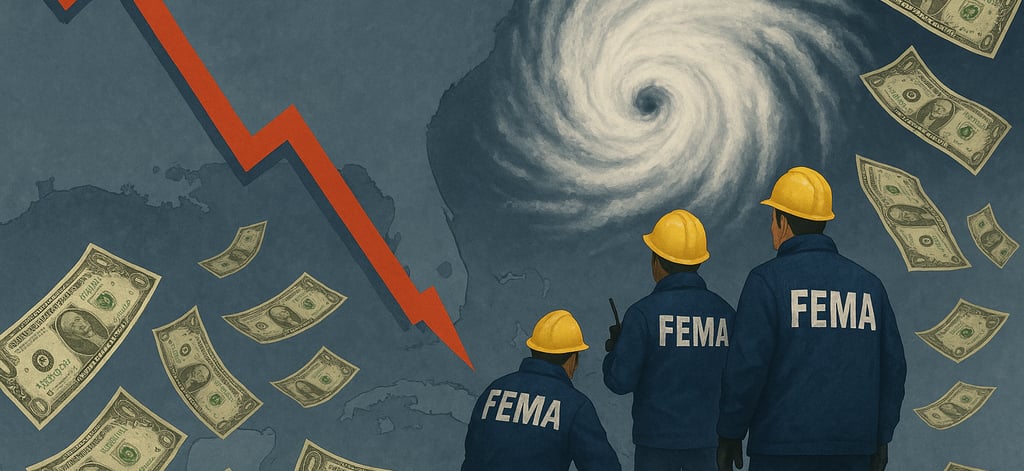Emergencies Don't Care About the Economy
As the 2025 hurricane season looms, emergency managers and public health professionals are facing a double threat: natural disasters on the horizon and a potential economic recession already taking shape. Economic recessions don’t just disrupt markets - they directly undercut public health and emergency response systems. This kind of economic instability hits emergency systems where it hurts - funding, staffing, supply chains, and community resilience. With resources stretched and uncertainty rising, it’s time for a hard look at how downturns weaken our ability to prepare for and respond to health crises.
4/7/20253 min read


In early 2025, the U.S. administration implemented substantial tariffs on a wide range of imported goods, aiming to address trade imbalances and bolster domestic industries. These tariffs, ranging from 10% to 50%, have raised significant concerns among economists and financial institutions about potential disruptions to global trade and economic stability. Goldman Sachs recently increased its probability estimate of a U.S. recession within the next 12 months to 45%, up from 35%, citing tighter financial conditions and policy uncertainty. JPMorgan Chase similarly elevated its recession odds to 60%, highlighting escalating trade tensions and their likely impact on economic growth.
These developments underscore the complex economic landscape as the nation approaches the 2025 hurricane season, necessitating a strategic reassessment of preparedness and response plans by emergency managers and public health professionals.
Public Sector: Financial Constraints and Resource Allocation
During recessions, government revenue shortfalls typically lead to substantial budget cuts, critically impacting emergency preparedness. These financial restrictions reduce investments in vital public health infrastructure, training programs, resource stockpiles, and maintenance of essential services. During the 2008 Great Recession, numerous U.S. public health departments endured average budget reductions of 25%, severely affecting routine healthcare activities, vaccination campaigns, and disease surveillance systems. Federal emergency preparedness funding also diminished, resulting in staffing shortages and limited disease outbreak response capabilities.
Cities such as Detroit and Baltimore notably struggled during this period, forced to reduce public health outreach, preparedness exercises, and infrastructure maintenance to cope with economic austerity. Emergency managers were frequently forced to choose between funding immediate response actions or investing in long-term preparedness initiatives, demonstrating the critical need for strategic prioritization.
Corporate Sector: Operational Risks and Financial Pressures
Recessions impose significant financial stress on healthcare organizations, often resulting in deferred infrastructure maintenance, reduced staffing, and vulnerable supply chains. These issues dramatically impair healthcare delivery during natural disasters, as seen in Puerto Rico following Hurricane Maria (2017). Financially distressed hospitals suffered catastrophic infrastructure breakdowns, prolonged power outages, inadequate generator backups, and critical staffing shortages, severely compromising patient care.
Additionally, economic downturns destabilize pharmaceutical and medical equipment supply chains as companies streamline production to reduce costs. The 2008 economic crisis saw several pharmaceutical companies reducing inventories, leading to shortages of critical medications, vaccines, and medical supplies. Emergency managers should engage healthcare corporations proactively to develop resilient contingency plans and robust supply chain agreements before disaster strikes.
Personal Sector: Economic Hardships and Increased Vulnerability
At the individual level, recessions significantly heighten vulnerability to disasters. Reduced personal income, elevated unemployment rates, and limited healthcare coverage severely constrain people's ability to afford evacuation, medication, and necessary medical care during emergencies. The 2008 recession witnessed substantial increases in unemployment, causing many individuals to delay or avoid essential medical treatments, worsening chronic health conditions and increasing overall vulnerability.
Hurricane Katrina (2005) starkly demonstrated these vulnerabilities, particularly in economically disadvantaged areas like New Orleans. Many residents lacked the financial resources required for evacuation, transportation, or adequate health insurance coverage. The resulting humanitarian crisis underscored the urgency of establishing robust personal economic resilience initiatives, targeted financial assistance, and comprehensive emergency communication strategies to support underserved communities effectively.
Historical Context and Lessons Learned
Historical events like the Great Recession (2008) and Hurricane Katrina (2005) provide crucial insights. Katrina illustrated the devastating consequences faced by economically depressed communities during disasters, revealing significant gaps in public health infrastructure investments and preparedness planning. Emergency departments were overwhelmed, medical personnel shortages occurred, and logistical failures severely hampered response efforts due to inadequate economic resilience and planning.
Similarly, during the Great Recession, public health departments nationwide struggled with decreased funding and workforce reductions, substantially weakening their capacity for effective emergency response and disease prevention. These lessons highlight the importance of sustained economic support for public health infrastructure, especially during challenging economic periods.
Strategic Recommendations for Emergency Managers and Public Health Experts
Economic Resilience Planning: Advocate for consistent public health funding, emphasizing essential preparedness initiatives such as vaccination programs, surveillance systems, and emergency response training, even in times of economic austerity.
Strengthened Corporate Partnerships: Forge strategic alliances with healthcare providers, pharmaceutical companies, and logistics firms to enhance supply chain resilience, ensure the availability of critical medical supplies, and maintain operational continuity during disasters.
Community-Focused Preparedness: Develop and fund targeted preparedness initiatives tailored to economically vulnerable communities, ensuring equitable access to healthcare, community evacuation plans, and effective outreach to marginalized populations.
Personal Economic Preparedness: Promote community financial literacy, encourage emergency savings programs, and disseminate accessible information about economic support resources to enhance individual disaster resilience.
Data-Driven Resource Allocation: Utilize historical recession and disaster data to accurately forecast potential impacts and strategically allocate resources, ensuring preparedness investments remain effective and efficient despite economic constraints.
As the 2025 hurricane season approaches, emergency managers and public health experts must integrate these detailed economic considerations into preparedness strategies, ultimately enhancing community resilience and safeguarding public health amid concurrent economic and environmental challenges.
Health Response Alliance is a nonpartisan 501c3 tax-exempt organization.
All contributions are tax deductible to the extent provided by law.
Federal Identification Number (EIN): 33-2575005
© 2025 Health Response Alliance Inc. ALL RIGHTS RESERVED.
